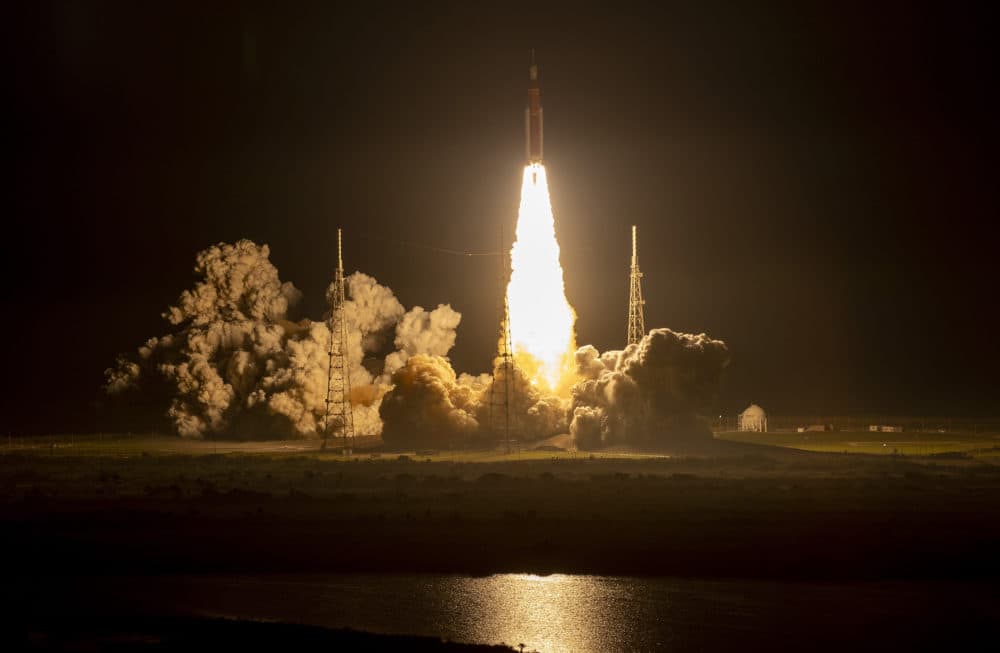Advertisement
Commentary
Artemis finally launched. But we’ll need humility to return to the moon

Artemis 1, which aims to send spacecraft and, eventually, humans back to the moon, launched early Wednesday after months of limbo. The rocket was initially scheduled to lift off Aug. 29, but that attempt and subsequent others were scrubbed because of mechanical issues and weather.
As NASA celebrated the successful launch of Artemis 1, the first mission of NASA’s Artemis Program, the rocket's earlier failures to launch — although expensive and disappointing — provide a critical element for successful space exploration: humility.
Humans haven’t been on the moon since 1972. The space race that culminated in Neil Armstrong stepping onto the moon was a long time ago, and it seems we've forgotten that space exploration is arguably the most difficult feat humans have ever attempted. Nothing in space, including returns to celestial bodies humans have visited before, is a given, which is easy to forget when Elon Musk is already thinking about the price of entry to one of his future Mars colonies (somewhere between $100,000 and $500,000, if you’re wondering).
Despite the countless unimaginable technological advances humans have made since 1972, going to the moon is hard. The U.S. remains the only country to land an astronaut there. Only three countries — the U.S., Russia, and China — have succeeded in landing spacecraft on the moon. Since the first attempt at a lunar mission in 1958, humans have attempted to send over 100 spacecraft to the moon, and roughly 44% of those attempts have failed. Traveling to and in space isn’t like riding a bicycle. No matter how many times we've done it, there’s no guarantee we can do it again.
NASA’s difficulty getting Artemis off the ground underscores the need to walk before running — or more accurately, to need to relearn both how to walk and run. The world, including NASA, is in a very different place than it was in 1969, which has technological, financial, practical, environmental and political implications, all of which have contributed to the launch delays that have plagued Artemis.
The Artemis Program’s Space Launch System rocket, capped with the Orion capsule that will house future crews, scrubbed its first launch due to mechanical issues, including a malfunctioning temperature sensor and cracked insulation foam. Engineers resolved the problems and NASA attempted to launch five days later, but that attempt was called off because of a fuel leak. NASA decided to regroup and work on the rocket for a few more weeks before trying again. Such issues aren’t unusual with something as complicated as a rocket or space shuttle, but it’s a reminder of fallibility and rustiness.
Advertisement
It remains to be seen whether problems with Artemis run deeper than lack of practice. The Space Launch System was designed 15 years ago as part of another space program. Former NASA deputy administrator Lori Garver told Scientific American that the design “was not focused on operability.” The system also contains components from a 41-year-old spaceplane (the obsolescence of NASA’s rockets since the Space Race is one reason some people are more confident in private companies like SpaceX or Boeing to design and produce them). Reusable rockets will become increasingly important for environmental, financial, and practical reasons, but “reusable” shouldn’t pertain to decades-old designs or parts.
Lack of political motivation and the recycling of old components both revolve around money. At the height of the space race, the U.S. government allocated roughly 4% of its budget to NASA, more than at any other time. After the U.S. landed astronauts on the moon in 1969, the cost of lunar missions seemed increasingly unjustifiable. The political motivation and the financial support for NASA have waned ever since and currently sit at about .5% of the federal budget, roughly 87% less than it received in the mid-1960s.
Mechanical (and human) failures haven’t been the only factors to delay Artemis. The Sept. 27 launch was delayed because of Hurricane Ian and the Nov. 14 launch was postponed because of Tropical Storm Nicole. These delays remind us that humans control relatively little when it comes to space travel. Thus, humans should focus on the aspects they can control, and on doing them right.
The Artemis program aims to land humans, including the first female and first astronaut of color, on the moon sometime around 2025. That lunar return will likely represent the next chapter of human space exploration. The costs are high, as are the risks. Artemis’ failed launches remind us just how high and how risky.
As astronomer Carl Sagan wrote in his 1994 book "Pale Blue Dot: A Vision of the Human Future in Space," “Modern science has been a voyage into the unknown, with a lesson in humility waiting at every stop. Many passengers would rather have stayed home.”
